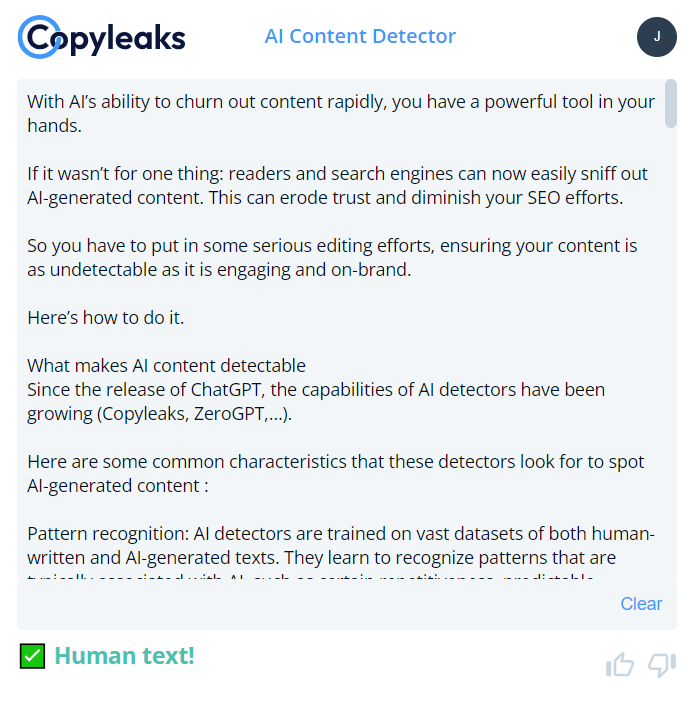Yes, AI detectors are getting smarter, but so are content creators.
There are now many prompting & humanizing strategies to make your content indistingishable from human writing.
In this guide, you’ll learn how AI detectors work, and actionable strategies to make AI-assisted content pass as human-written.
Which Signs Are Triggering AI Detectors

AI detectors like Originality.AI, GPTZero, Copyleaks.. rely on several algorithmic techniques to spot AI-written text. If your content gets flagged, it’s because it exhibits very specific patterns that match AI-generated writing. Here’s what these are :
1. Perplexity: How Predictable is Your Text?
Perplexity measures how surprising or unpredictable a piece of writing is. Human writing naturally varies in word choices, phrasing, and sentence structure. AI-generated text, however, tends to be more predictable because it relies on probabilities from large datasets. If your writing follows overly structured and expected patterns, it will have a low perplexity score, which raises red flags for AI detectors.
2. Burstiness: How Varied Are Your Sentences ?
Burstiness refers to the variation in sentence length and structure. Human writing naturally fluctuates between short and long sentences, while AI-generated text tends to be uniform. A lack of burstiness makes your content look machine-written.
3. Statistical Analysis: How Much AI Patterns your Writing Includes ?
AI detectors can also compare your text to vast datasets of both AI-generated and human-written content. They look for common AI patterns such as repetitive phrasing, excessive use of transitional words, or overly formulaic sentence structures. If your writing follows a rigid pattern, it’s more likely to be flagged.
4. Stylistic Consistency: How Rigid Is Your Writing Style ?
AI writing often maintains a consistent tone throughout an entire piece. Humans, however, naturally shift tone depending on context. You might be informative in one section, conversational in another, and persuasive elsewhere. A rigid, one-tone structure is a dead giveaway for AI-generated content.
Prompting & Humanizing Strategies to Bypass AI Detectors

LLMs like ChatGPT AI love following predictable AI-generated patterns. The good news? You can minize these patterns with a few key strategies.
1. Customize AI Writing Style
AI models default to a generic, neutral tone easy to be recognized. You want to distance yourself as much as possible from this “default voice”. To do that, you want to train your LLM on a unique style by giving precise instructions.
Use prompts like:
Whenever you write a text, stricly follow each of these guidelines : [style guideline 1] [style guideline 2] [style guideline 3]
Better yet, feed ChatGPT samples of your writing so it learns your unique tone, sentence structure, and phrasing. Try this:
Here’s a writing sample to determine my style. Only reply ‘ok’ if the extract is clear. Here’s the extract: [insert writing sample].
This method forces the AI to mimic your natural writing patterns, making your content feel more human.
2. Diversify Sentence Structure and Formatting
AI-generated content often sticks to a predictable length of sentences, paragraphs. There’s always some kind of pattern that you can figure out. To avoid this, vary how you present your content:
- Use a mix of short and long sentences. AI often maintains a fixed rhythm, so breaking this pattern adds human-like unpredictability.
- Alternate paragraph lengths. Some sections should be one to two sentences long, while others can be more detailed.
- Alternate between bullet points, lists, paragraphs and subheading in a random order
The goal is to break robotic patterns and add a natural flow to your writing.
3. Remove AI-Specific Repetitions and Redundancies
AI-generated content tends to overuse common phrases such as:
- “In today’s world…”
- “In a time where”
- “Fast-paced”
- “Delve in”
- “Not only, but also…”
- “It does this, this, but also this” (tricolons)
These phrases can trigger AI detectors. So you better minize theses expressions and get straight to the point with more specific, engaging language.
4. Infuse Your Own Ideas and Knowledge
One other way to break predictable patterns is to feed your LLM with your own sponteanous draft ideas.
A great way to do this is to first write a rough outline yourself, then have ChatGPT expand on it. This forces AI to structure its output based on your unique ideas rather than generic internet content.
Provide your LLM with :
- Personal experiences or examples. AI can’t replicate your real-life stories.
- Original insights. If you’re an expert in a field, introduce fresh perspectives AI wouldn’t generate.
- Strong opinions or subjective takes. AI-generated content tends to be neutral. By adding a clear stance you force it to provide more original views.
You can use a prompt like this :
Generate an outline for an article about [insert topic] using the following key ideas: [Insert your main ideas or bullet points]
5. Make Your Edits Manual for a Final Human Touch
Even with AI assistance, always manually review and edit the final draft. Here’s what to focus on:
- Rewrite sections that feel too uniform.
- Inject personality. Add humor, rhetorical questions, or conversational phrasing.
- Check for AI-typical phrasing and remove it.
- Read your text aloud. If it sounds robotic, tweak it to flow more naturally.
Manual intervention is the ultimate AI bypass because it ensures your final content reads naturally, free from detectable AI patterns.
Do AI Humanizers Work?

AI humanizers claim to make AI-generated content indistinguishable from human writing, but do they really deliver? The short answer: not really.
While they may slightly tweak phrasing and sentence structure, these tools are still fundamentally algorithmic. They don’t introduce fresh ideas, emotional depth, or nuanced perspectives—things that make human writing unique.
If you’ve ever run AI-generated content through an AI humanizer, you’ll notice that the result often feels… different, but not truly human. It might shuffle words around, change sentence flow, or swap synonyms, but it doesn’t change the actual enthropy of the text.
AI detectors can still recognize AI-humanized content, as these tools follow predictable patterns, just like AI itself.
Why ? Because :
- They rely on surface-level changes. Instead of fundamentally altering the structure or intent of a piece, they just rephrase sentences. A paragraph that reads “AI content is easy to detect because it follows patterns” might become “Since AI writing tends to be predictable, it’s simple to identify.” Different words, same logic. Detectors can still flag it.
- They don’t introduce originality. AI humanizers are still working with existing AI-generated content. They don’t add new insights, creative ideas, or depth to the piece. This makes them easy to spot compared to truly human-written articles.
- They fail to capture tone and nuance. AI struggles with context shifts, humor, sarcasm, or strong personal opinions—AI humanizers do nothing to fix this. They simply make AI-generated text “sound” more human without actually making it smarter or more engaging.
At best, these tools act as a first step in making AI-generated content passable, but they can’t replace manual editing.
What’s the Better Alternative?
If your goal is to truly bypass AI detectors and create content that feels human, the answer isn’t an AI humanizer—it’s the prompting and humanizing strategies I outlined here.






